-
Wider
areas of Central Balkan with particular mines of Timok's eruptive
basin and basin of Rudnik and Kopaonik, are some of the few richest
archeometalurgic provinces of Old Continent. Leaving the primary
farming period behind metallurgy and mining were implementing Balkan
development, development that testifies about the cultural
independence of both Balkan and Europe, in opposition to influences
spreading from Near East. Civilisation of Metal Age Europe started the
unrestainable progress on the heights by the Danube banks.
-
|
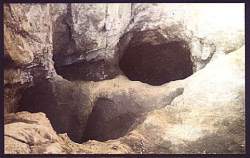
|
|
Eneolithic
mines shafts with access platforms on Rudna Glava mine |
- Early
Eneolithic mine
Rudna Glava near Majdanpek (5000 year B.C.) is an example of the oldest known technology of
copper acquiring. It was under researches in the period from 1968. to 1989. as a
part of the "Old Mining and Metallurgy of the Central Balkan" project, led by
Borislav
Jovanovic (Archeological Institute SANU) and
Ilija Jankovic (Museum of Mining and
Metallurgy in Bor). Only three decades after this discovery Rudna Glava was accepted as
one of the basis items of European civilisation.
|
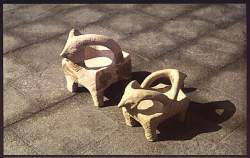
|
|
Sacrificial altar
made for farmer's gods found in Rudna Glava shafts |
- Old Europe was colonized by population of eldest farmers which had
moved from the South of Balkan toward Central Europe, during the 7th and
6th
millennium of Old Era. Neolithic farmers worshipped Great Goddess - Great Mother, life
giver, ancient one. They celebrated life renewal of plants, in the
constant change of seasons.
- Usage of original metals-copper and gold opened portals of unknown
underworld, world so rich, but hidden that only Gods could show the way through it. New
Gods were bolt throwers, great blacksmiths or smelters. Deep in the
silent shadows of the
first mining shafts, natural ore canals, through which the ore was
flowing toward the
surface of Earth, for the first and the last time farmers Gods met
new, strong and
young Gods. They ruled over the powers unlimited, which forced matery to
miraculous metamorphosis from
shapeless ore blocks - new dazzling metal emerges.
- In the deepness of Earth Transformation of the
circle flow of
nature into the linear historical time occurred. At the same time parallel forms, of
natural and technological appeared. Consequences of this turnover can be understood
perhaps now a days.
|
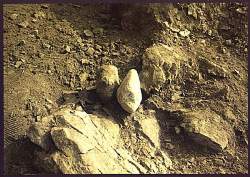
|
|
Oldest
miner's tools, mallets - round pebbles with horizontal gutter |
- The
oldest mining technology known from Rudna Glava solved
many mysteries of the origin of primary mining and mineralogical knowledge indicating
hard and long way-way of new, inspiring technology. Developed skills of Rudna Glava miners
ore are indicated by the emptiness of the shafts no less than 20m deep.
- Long string of stone mallets, bigger river stones made from
volcanic rock, gives evidence of the higher specialization of primitive tools for
different and various productive purposes. As for the chopping of the
pieces different types of wedges were used, while the tools made from deer horns were used
for gathering the ore already chopped.
- When the ore vein was discovered,
the access platform was
built round its flooding canal. Afterwards the hard ore mass was broken into pieces by
circle hits of stone mallets, hanged either on a rope or leather belt. In the depths,
technique of sudden warming and cooling was used. Dishes from ceramic pantries of bigger
volume were used for pouring the water over the hot ore blocks. Cracked, blocks were
further smashed and broken into pieces.
- The ore obtained was taken to the
surface in bags, and it was
distributed further to the settlements near by. Further metallurgic
processes are
considered to be a part of technological circle of handworks in that
early period of metal
usage.
- Union with the experience of stone tools production is very
obvious in copying the most successful forms into new material - metal.
Creation of native
metallurgy and copper mining expires from the fact of relation between
the old and new
technologies, which in unbroken chain spring from each other.
- Knowledge acquired from Rudna Glava as much as from
Ai-Bunar
prehistoric mine placed in Bulgarian Trachia had altered completely developing and
hronologic chart of eldest metal industry in European pre-history. An opinion that
original knowledge on field of metallurgy was spreading from highly developed
centers of
Near East, over the Greek coasts and walleyes of Vardar and Morava toward Panonian plains and upper
flow of the river Danube was supported for the long period of time.
Apparently, mining areas
emerged from the areas of Central and East Balkans as the original focuses of independent
development of copper metallurgy.
- Arise of the new technologies determined the influence of the very
same legalities believed to be discoveries of modern time: increased demand for
raw
materials, gathering of mineralogical knowledge in the field of developed industry of
stone and flint tools, richness of visible and accessible ore, increased activities
of using
new metal tools, constant increase of metal demand, and finally production of
increased
quantities of metal in circulation (gold and copper). The last can be entitled
(If modern
aspects of production process allows) original metal market.
|
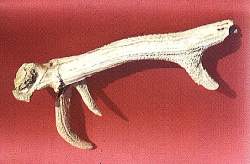
|
|
Pickaxe
- rake made
from deer horns, from the bottom of the shaft at Rudna Glava |
- Rudna Glava near Majdanpek is not the biggest mine of primitive
copper metallurgy but the archeometalurgic monument which shafts keep evidence of
the eldest technology of copper mining.
- The original mallets-rock made from deer horns long and massive
bone awls, or punches, pantries for ceramic dishes were found on the spot, stopped in the
course of time.
- When the
carbonate minerals of the copper (malachite and azurite) accessible to technology they had used
were exploited, Vinchan's miners of early
eneolith left the mine. By the long hand of coincidence nearby bearings of Majdanpek and
Bor became exclusive destinations of miners from Copper and Iron Age, which
automatically left Rudna Glava aside. This modest Iron and Copper ore
bearing (magnetite and halcopiryt) was used once more in Roman times - during the 3rd century A. D. That's why
the script of eldest mining remained in Rudna Glava legible and
understandable. As one of
the sort preserved in the changes of Eras, it made this place a spring of knowledge
about the genesis of the eldest copper metallurgy in pre-historic Europe.
Rudna Glava, eneolithic copper mine although damaged by works on
the surface excavation site of modern magnetite mine, have preserved all
information needed
for the complete reconstruction of eldest technology of acquiring carbonate and oxide ore
of copper. Essential value of the mosaic - gathered in one - is crystal survey of native
home crafts and experience. Some as vivid engravements of ancient
artists - Vincha's miners
emerged from past so distant it seemed lost, on this locality. They were inhabited in the
area from Northern Macedonia over the plains of Southern Panonia, during the period of 4th millennium B.
C. Tools and ceramic works made from local raw materials springed according to style
and form from distant traditions of Younger Stone Age (neolith), show no evidence of
foreign influence.
|
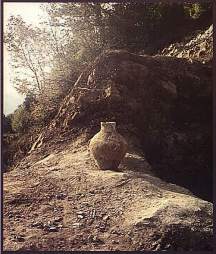
|
|
Amphora
from ceramic pantry on the excavation site |
- The ways of developing this eldest skill of ore smelting and metal
acquiring are dim and vague, lost in opaque mists of primeval dusks.
- Nevertheless
Rudna Glava has marked the beginning of primary mining and metalurgy representing it as common knowledge of Vincha's
populations inserted
in earning of every village. Ore was pulled out in times favourable spring or summer
months, it was cleared and prepared for proccessing and taken away toward villages. String
of technologic proccessing became developed in small manual smelteries and blacksmith
shops - from the forging of native copper to casting of the shorter strings of massive
copper tools and weapons. Quantities of the metal used for copper objects
designing were
preserved in many smelteries of Plochnik (smelter pantries). This village of Vincha's
culture in Toplica, testifies that tehnological improvement of the primary copper
metallurgy was exceptional.
- Improvements of copper casting acquired by constant
attempts to developed metal harder than copper (by adding arsenic, lead and
finally tin) brought to
creation of bronze alloy which exquisite qualities preserved its value till modern times,
at the end of 4th
millennium B.C.
|